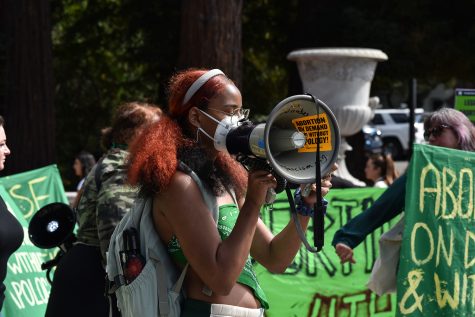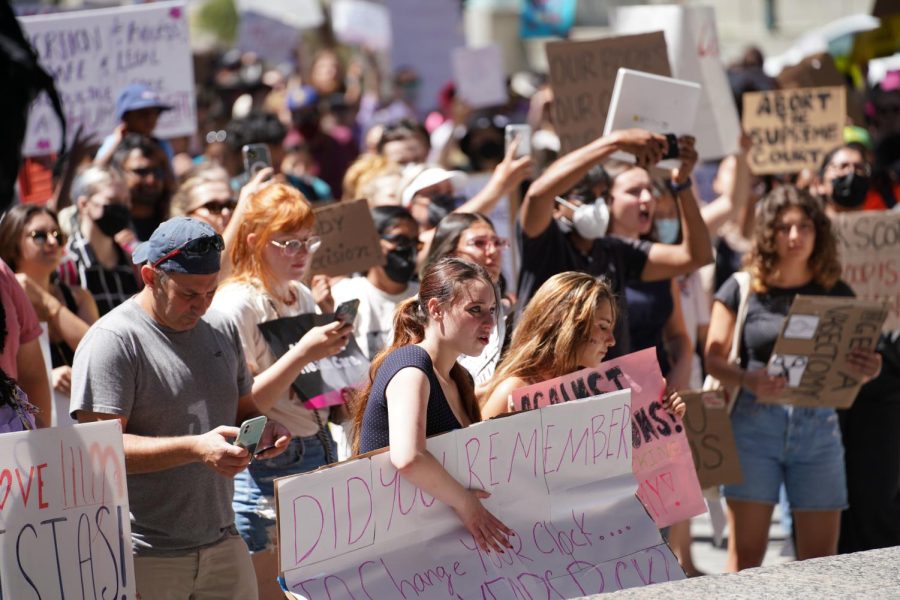Activists congregated at the San Jose City Hall on June 25 to protest the overturning of Roe v. Wade. Photo | Anna Jerolimov
Rising up for Roe
Student activists recount their involvement in abortion rights activism
Rise Up 4 Abortion Rights Core Organizer Jayce Burner attended their first protest on April 9, 2022. Despite having to leave early, they still remember the spark of exhilaration they felt marching alongside 70 other protestors and wearing the green that represents the fight for abortion rights to millions of Latin Americans — the sense that “there [was] something we [could] do about this, [and] we [didn’t] have to rely on people in power.”
Two months later, on June 20, 2022, the Supreme Court overturned Roe v. Wade, dismantling five decades of precedent protecting the right to an abortion and setting off a wave of protests across the U.S. For English teacher Vannessa Nava, the decision wasn’t surprising, given the 6-3 conservative majority on the Supreme Court.
“I knew that [it] was coming, but it was still deeply disheartening,” Nava said. “Realistically, I’m beyond the years that I’m [going to] have a child, but it doesn’t mean that it doesn’t affect me. It really is a deep and grave loss that will have far-reaching repercussions for millions of women in the country.”
On the other hand, senior Saloni Gupta recalls being shocked into silence for five hours when her mother broke the news, struggling to imagine “a girl in the exact same position as [her], with the same future and ambitions as [her], now [potentially] having her life ruined.” Her frustration spurred her to join RU4AR, which aligned with her hope to participate in immediate action.
“Personally, I’ve never had an abortion, and I’ve never been scared of being pregnant,” Gupta said. “But I really care about social injustices. They pierce me because I just cannot imagine being in that situation, and the fact that so many women are forced to be [pregnant] because of some idiot state representative who’s pro-life riled me up.”
Burner, an eighth grader at Longfellow Middle School, chose to join RU4AR because it was one of the few groups actively protesting in the streets rather than resorting to education. Since then, they have helped coordinate protests across the Bay Area as a leader of the youth subsection, hosting weekly meetings for members to share experiences and ideas.

“The day Roe v. Wade was overturned, and the day after, we were in the streets of San Francisco with thousands of people,” Burner said. “We’ve learned a lot as individual people within [RU4AR] – people who have been with us since before Roe v. Wade, people who joined the day it was overturned or people who joined last week, we’re already seeing so much growth. People [are] getting better at agitation or learning more about the history of Roe v. Wade, [and] growing, all [in] different ways.”
Gupta, who has delivered speeches and participated in several marches as a part of RU4AR, also engages in activism on a local scale as the president of MV Politics Club. Although the club remains neutral towards abortion as a whole, Gupta created a committee for members to help organize abortion-related activities, such as a poster set up in the MVHS library where around 50 people wrote their thoughts on Roe v. Wade’s overturning.
“[At] Monta Vista, I don’t like that [abortion is] not talked about that much,” Gupta said. “A majority of people are pro-choice, but they’re not actively pro-choice. Most of my close-knit friends have never attended a protest. It was just like, ‘Oh, it happened but I’m in California, so it’s not impacting me.’ I’m hoping to break [that mentality].”
While Burner believes everyone can and should try activism, having started at LMS with three friends and a Dollar Store banner, they acknowledge that participating in mass protests can be stressful due to the police presence. One incident that stood out to Burner was their first act of civil disobedience when demonstrators laid down with bullhorns and blocked a street in San Francisco with Raging Grannies dressed in black pretending to mourn around them. Although police detained several protestors, Burner points out the necessity of civil disobedience to attract attention.
“[Civil disobedience shows] that when abortion is illegal, this is [what happens],” Burner said. “Women go to unsafe extents, they [do] back-alley abortions, especially young women who can’t afford [an abortion] or [live] in a state where abortion is not legal. This is what will happen to women – it will decimate their lives.”
At least 13 states have banned abortion since June, and others have enacted medical restrictions and harsher time limits. In contrast, California explicitly added abortion rights to the state constitution with the passing of Prop 1 in November and introduced dozens of other policies expanding abortion access starting in 2023.
Although Gupta and Burner agree that these measures are a promising step, both believe making California a sanctuary state is not enough, highlighting the importance of legalizing abortion nationwide.
Following the Dobbs v. Jackson decision that overturned Roe v. Wade, Nava joined a protest at the Planned Parenthood clinic near her house, where she used to regularly see protestors harass women who tried to enter. While Nava says this was the extent of her involvement, she reflects on the importance of activism on any scale to preserve not just abortion, but all civil rights.
“I don’t think that we should be quietly accepting the erosion of our rights — that’s not very American,” Nava said. “A lot of things that are American are quite shameful, but one that is something to be proud of is fighting for rights and maintaining them, if not expanding them.”
Ultimately, Burner hopes to “bring society to a halt” until abortion is legalized nationwide. Creating such a movement begins, they explain, with individuals.
“The way that we’ve made change in this country — the way women got the right to vote, the way we got the right to abortion, the way all of this happened in the first place, was through mass resistance in the streets,” Burner said. “You can’t have that without individuals. You have to have people who are willing to fight, people who can make banners, people who are drawn to agitation, people who have something to say. You need all these individuals to be a part of this movement to make it really happen.”

